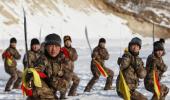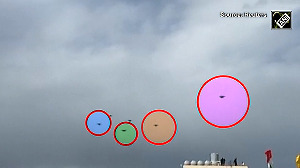Major General Sujan Singh Uban, a legendary veteran of the Second World War, was a natural choice to raise, train and command the Special Frontier Force and mould them into a well oiled fighting machine, recalls his son Inspector General Gurdip Singh Uban (retd), who led SFF troops during the Kargil War.

The mystic, celestial, Snow Lion, Gang: Seng Ge in local lore, derives its name from the Sanskrit Simha.
It is the emblem of Tibet showcasing its eternally snow covered mountains and glaciers, even as it symbolises power, strength, fearlessness and joie de vivre or the joy of living.
It is also the symbol and flag of the intrepid, fearless warriors of the Special Frontier Force, who have figured so prominently in the recent clashes in eastern Ladakh.
The strategic importance of Tibet cannot be over emphasised.
It is the roof of the world, with vast mineral and natural resources.
The mighty rivers that emanate from its expansive glaciers such as the Brahmaputra, Yangtse, Yellow river, Mekong, Salween and the Indus, together with thousands of their tributaries have nurtured civilisations in peripheral countries for centuries.
Kailash Mansarovar with its spiritual overtones tugs at the heart strings of every Indian.
In an act of naked aggression ,China occupied Tibet in 1959.
A buffer was eliminated, and the de facto boundary of China, became contiguous to that of India.
A boundary deliberately left un-demarcated to enable further expansion.
As a first step, therefore there is need to challenge the very legitimacy of China's claim over Tibet.
For centuries Tibet has been an independent nation.
In the 16th century Genghis Khan invaded, captured and ruled China for over a century.
During this period his grandson Kublai Khan signed an independent treaty with Tibet.
The Vth Dalai Lama having been murdered, China began to interfere in the affairs of an independent Tibet.
After the fall of the Quing dynasty in 1913, Tibet expelled all Chinese officials and troops and declared itself independent.
A stamp of approval was accorded by the signing of the Simla Agreement in 1914 between the British and the Tibetan government; also attended by a Chinese representative.
The Communist party of China, which came to power in 1949 began its experimental programmes.
Soon China was staring at a famine caused by the quixotic Great Leap Forward, an economic and social disaster.
It was under these circumstances, that Mao Zedong turned to Tibet, and declared, 'Tibet is the palm that we shall occupy and then go after the five fingers. Mao meant Ladakh, Nepal, Bhutan, Sikkim and Arunachal Pradesh.
Consequently, in 1959, China committed the naked act of aggression of an independent Tibet, to which India acquiesced, till our Hindi Chini Bhai Bhai dream was rudely shaken in 1962.

India is dealing with a bellicose neighbour, with an obsession for assertion of rights over land which their predecessors may have acquired through conquest or guile.
Their own history of submission for over a century to the Mongols, followed by the Japanese, and the colonial powers that ruled over them are glossed over.
China has land borders with 14 neighbours covering an estimated 22,100 kilometres.
As its economic status burgeoned, so did its military muscle.
Based on a medieval mindset of the Middle Kingdom and head of the Confucian family, China embarked on claims based on perceived imbalances of treaties forced on them when the country was weak.
Some of these have since been resolved after bloody clashes such as with Russia in 1969 and Vietnam ten years later, while others have been resolved through a combination of lucrative offers of money, trade and guile.
In most cases, the end result has been such, that victory can be claimed by both sides.
Russia accepted half of China's claim.
Kazakhstan was given lucrative economic deals.
Kyrgyzstan retained 70% of the land, ceding just 30% and so on.
Towards the end of April this year, four motorised and six Mechanised divisions of the People's Liberation Army's Western Theatre Command having completed their exercises on the edge of the Gobi desert, took to the Xinjiang highway, and in a well planned and rehearsed move branched off onto a series of feeder roads on the Line of Actual Control in eastern Ladakh.
Once the PLA troops were in position, they initiated multiple incursions across the LAC into what had been 'No Man's Land' patrolled by both sides.
This included areas in the Depsang plains threatening the forward airstrip of Daulet Beg Oldie as also north and south of the expansive Pangang Tso salt water lake.
The world watched with dismay as soldiers of the two nuclear armed Asian giants engaged each other in a slugfest on the snowy summits of the Himalayas.
In the melee that followed, they went at each other with clubs studded with barbed wire, machetes and rocks, crushing skulls and bones in the most barbaric manner.
Not a shot was fired, but the Indian Army, which was initially surprised, reacted swiftly and with bravery and courage inflicted severe casualties on the Chinese side.

The inevitable fallout of these actions was by both sides jostling for the heights leading to a stalemate.
Suddenly, on the night of August 29/30 in a surprise move, the Indian Army turned the tables by occupying heights that were not only of great tactical importance north and south of the Pangong Tso lake as also dominating the Spangur Gap, but were now looking into the innards of the Chinese depth localities at Moldo including their armour, guns and reserves.
This amazing feat was accomplished primarily by a ghost army, the Special Frontier Force.
Who are these superhuman troops? and what are their antecedents?
They are the dreaded shadow warriors of the Special Frontier Force.
During the era of the 'Great Game', the British employed natives to patrol their lands, which included the Tibetans.
It was the Mustang base in the northern border range that escorted the 14th Dalai Lama to safety to India during the 1959 rebellion.
As a consequence of the 1962 War, the Nehru government ordered the raising of an elite commando force called the Special Frontier Force comprising amongst others, Tibetans who had sought refuge in India along with the Dalai Lama.
Major General Sujan Singh Uban, a legendary war veteran of the British Army famous for his daring exploits with the Long Range Desert Group in the Middle East, and guerrilla wars in Burma during the Second World War, was a natural choice based on sheer merit.
He was tasked to raise, train and command this nascent force as also mould them into a well oiled fighting machine.
To enhance their inherent fighting capabilities they were given airborne training in addition to expertise in mountain and jungle warfare.
Initially aided and equipped by the United States, they quickly indigenised and were soon on their own feet.
The opportunity to display their mettle as also to repay their host country came during the 1971 War.
As the Indian Army moved in with their major thrust into East Pakistan, the SFF, while supporting the flank of the Indian Army, by a blitzkrieg, cleared the Chittagong Hill Tracts, destroyed the Kaptai dam and encircled and prevented the escape of Pakistan's 97 Brigade and No 2 Commando Battalion, all of whom were taken prisoner.
The SFF was poised for the capture of Chittagong port when a ceasefire was declared; a daring move which paid handsome dividends.
This earned them the title 'Phantoms of Chittagong'.

Having performed exceedingly well in the Indian Army, including out of turn promotions, taught strategy as a Senior Instructor at the Army War College, I had the added advantage of having served for more than 16 years in Kashmir and all along the northern borders for which I was awarded the Vishisht Seva Medal.
Accordingly, I was selected for the Special Frontier Force.
This also enabled me to fulfil a family commitment.
Based on my record of service I was promoted as Inspector General to command the Special Frontier Force and was privileged to command them during the Kargil War in battles fought at heights of 14,000 feet and above in sub zero temperatures; actions which were lauded both in the Ladakh and Kargil sectors.
The security for the Amarnath Yatra was provided by the SFF that year.
It would be fallacious to surmise that there will be any resolution to the ongoing stand-off in Ladakh in the near future.
Let us assume that both countries wish to avoid a full scale war.
The road ahead perforce will have to be evolved and based on a study of the manner in which China negotiated their boundary disputes with 13 of its neighbours and the results achieved.
There can be little doubt that the PLA's actions in Ladakh were pre meditated, planned and executed with precision.
The Chinese were fully aware that they were transgressing into 'No Man's Land'.
With a pre-determined aim in mind they proceeded to secure tactical heights and gained access to areas which would forestall a counter-offensive by the Indian Army.
To expect them to vacate these areas at this juncture would be naive.
The matter can best be settled through negotiations, but from a position of strength.
Having taught strategy at the Army War College, I can state with certainty that the PLA, in its present configuration and posture, has immense weaknesses which they would be aware of, and which should make them uneasy.
It is imperative to form a Group of Experts from amongst retired professionals who have a proven track record from the army, navy, air force. Also, diplomats, intelligence, cyber and cartographic experts who can plan and prepare short, medium and long term goals to be achieved within a suggested time frame.
Most importantly, besides the experience, they have the time.
Their recommendations should be sent to the PMO for approval.
Once approved, they will then be sent to the concerned ministries and Services Headquarters where competent officers are available to implement them.
It can no longer be a part-time issue to be addressed only when a crisis occurs.
The crisis is upon us now.
Let us play down the rhetoric, adopt a pragmatic approach and permit the Aura of the Snow Lion to permeate its shadow on the Roof of the World.
Inspector General Gurdip Singh Uban (retd) commanded special forces and served as a senior instructor at the Army War College.
Feature Presentation: Aslam Hunani/Rediff.com












 © 2025
© 2025